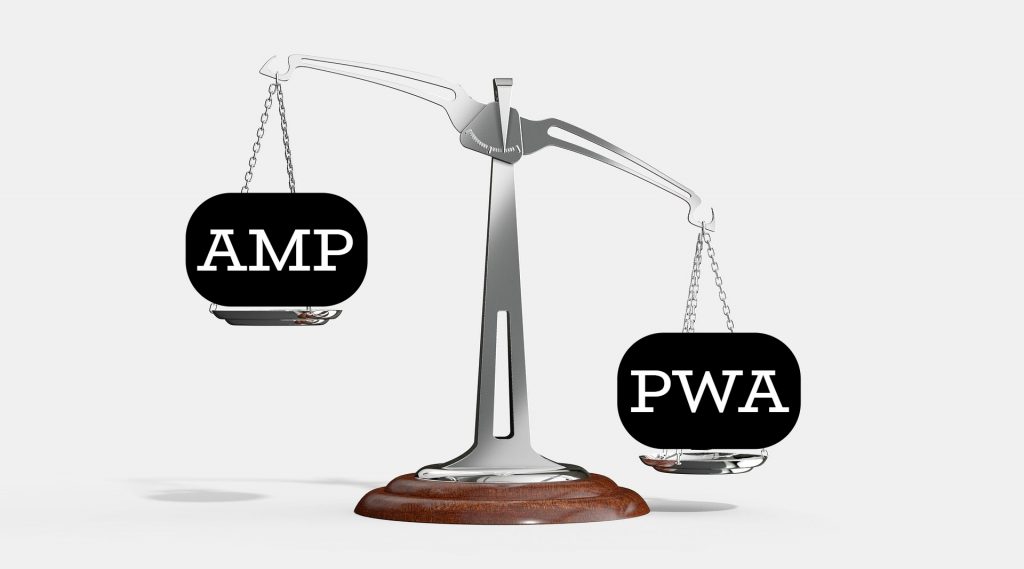Presently it’s undeniably true that the majority of the total population have mobile phones. In the past, not many individuals had internet in their home since PCs were not very affordable to run the internet and mobile phones were absent that time. Somewhat recently, we have seen the plunging of mobile phone costs and mobile data has likewise got less expensive. Many people have mobile phones now and run internet on their mobile phones.
In 2016, mobile traffic surpassed desktop traffic by asserting 51.3% internet users as mobile phone users. Because of that we are seeing organizations chipping away to offer great types of services to their potential customers. So to take into account the requirements of mobile phone users, AMP and PWA was introduced in 2016.
In this article, I am going to introduce you to AMP and PWA and their differences.
Let’s jump right into it

What is AMP?
AMP was launched officially in 2016 as Accelerated Mobile Pages, a Google-led open source project. Since then it has evolved so much. In the past, the websites were not designed and optimized for mobile phones but after the huge increase in the number of smartphone users now businesses are realizing its importance. Now developers are designing websites keeping the mobile version in mind. At present, AMP goes beyond websites. It has extended to build ads, draft emails and stories.
In order to build mobile friendly websites, the unrequired (inline) Java script is eliminated. In addition to that, we limit CSS to 50kb for inline use. And to give a CDN like functionality, Google captures the website content. AMP ads enhance ROI by getting better CTR.
Read also: How to increase sales with website design?
What is PWA?
PWA stands for Progressive Web App. It is designed in such a way so as to provide the user with a mobile application like feel and experience by accessing its web page on a browser. In other words, you are getting, let’s say you are browsing a web page of a particular website but the feel, look and experience of it will make you feel like you are using the mobile application and not the browser. So you don’t need to download the mobile app because you are getting a mobile app like experience on a browser. It targets on providing mobile app like features
- Total app like user interface.
- Faster shift between pages.
- Ability to access offline content.
- Ability to send push notifications.
Let’s take an example of the most famous e-commerce giant Amazon. If you access Amazon’s website on a browser and then on the Amazon’s app you will see that they will look pretty much the same, the navigation and other features will also probably be the same. So, then if you are running low on storage try Amazon on browser. Additionally the PWA version consumes comparatively less data than a native app.
Now how AMP is different from PWA? Let’s find that out
How AMP and PWA are different from each other?
✅ Definition
- AMP- It is designed in such a way so as to provide a faster and mobile friendly website on the mobile phone.
- PWA- Web page which will give you an app like feel and experience
✅ Method of development
- AMP- Unnecessary Java script is stripped off and CSS is restricted to 50kb to provide faster loading speed and seamless user experience.
- PWA- PWA is coded using Java script mostly. Like a mobile app to provide a web app kind of experience and comes with functions like push notifications, app like navigation.
✅ Recommended for
- AMP-Generally recommended for all publishers trying to target mobile users.
- PWA- PWAs are highly recommended for and used by e-commerce websites and social media organizations.
✅ Benefits
- AMP- Improvement in loading speed of mobile friendly pages, advantageous for mobile Search Engine Optimization, Faster loading helps draw more traffic, Better ad views. Chances of ranking higher on Google search top stories leads to a higher Click-Through-Rate.
- PWA- Mobile App like navigation and features, engaging, fast and reliable. Remove the necessity to design apps for different OS using different languages. User can access website offline too, better alternative to downloading an app that uses storage and data as well.
Final Outcome
- AMP- Faster loading speed of the website coupled with enhanced user experience.
- PWA- Website giving mobile app like features and functions and provides an app like feel and user experience.
Wrapping it up
To wrap up I would say that understanding the significance of mobile phone optimized website is an incredible progress toward an all-inclusive web services and user experience. Technology is continually advancing and moving towards giving a reliable, secure and user friendly experience.
Not sure how to optimize your website for mobile phone or want to improve your digital marketing strategy? Hire Digital Marketing Company in Singapore.
For more informative and interesting articles, just get in touch with us.
